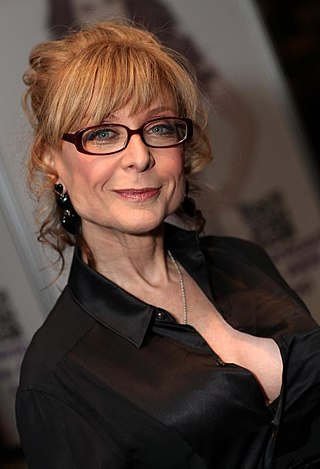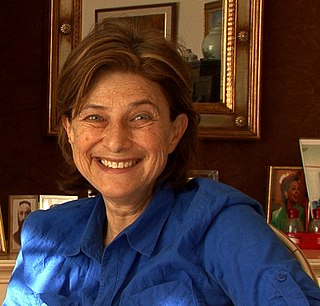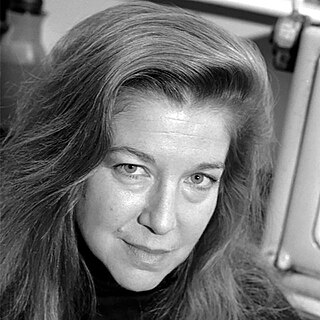Related Research Articles
Video art is an art form which relies on using video technology as a visual and audio medium. Video art emerged during the late 1960s as new consumer video technology such as video tape recorders became available outside corporate broadcasting. Video art can take many forms: recordings that are broadcast; installations viewed in galleries or museums; works either streamed online, or distributed as video tapes, or on DVDs; and performances which may incorporate one or more television sets, video monitors, and projections, displaying live or recorded images and sounds.

Annie M. Sprinkle is an American certified sexologist, performance artist, former sex worker, and advocate for sex work and health care. Sprinkle has worked as a prostitute, sex educator, feminist stripper, pornographic film actress, and sex film producer and director. In 1996, she became the first known porn star to get a doctoral degree, earning a PhD in human sexuality from the Institute for Advanced Study of Human Sexuality in San Francisco. Identifying as ecosexual, Sprinkle is best known for her self-help style of pornography, teaching individuals about pleasure, and for her conventional pornographic film Deep Inside Annie Sprinkle (1981). Through the production of feminist based pornographic content, include understanding of female genitalia and pornography based on women's desires, Sprinkle has contributed to feminist pornography and the larger social movement of feminism; she is also known for contributing to the rise of the post-porn movement and bisexual/lesbian pornography. Sprinkle, a bisexual woman and member of the LGBTQ+ community, married her long-time partner Beth Stephens in Canada on January 14, 2007.

Performance art is an artwork or art exhibition created through actions executed by the artist or other participants. It may be witnessed live or through documentation, spontaneously developed or written, and is traditionally presented to a public in a fine art context in an interdisciplinary mode. Also known as artistic action, it has been developed through the years as a genre of its own in which art is presented live. It had an important and fundamental role in 20th century avant-garde art.

Marie Louise Hartman, known professionally as Nina Hartley, is an American pornographic film actress and sex educator. By 2017 she had appeared in more than one thousand adult films. She has been described by Las Vegas Weekly as an "outspoken feminist" and "advocate for sexual freedom", and by CNBC as "a legend in the adult world".

Chantal Anne Akerman was a Belgian film director, screenwriter, artist, and film professor at the City College of New York.
Martha Rosler is an American artist. She is a conceptual artist who works in photography and photo text, video, installation, sculpture, and performance, as well as writing about art and culture. Rosler's work is centered on everyday life and the public sphere, often with an eye to women's experience. Recurrent concerns are the media and war, as well as architecture and the built environment, from housing and homelessness to places of passage and systems of transport.
Barbara Kruger is an American conceptual artist and collagist associated with the Pictures Generation. She is most known for her collage style that consists of black-and-white photographs, overlaid with declarative captions, stated in white-on-red Futura Bold Oblique or Helvetica Ultra Condensed text. The phrases in her works often include pronouns such as "you", "your", "I", "we", and "they", addressing cultural constructions of power, identity, consumerism, and sexuality. Kruger's artistic mediums include photography, sculpture, graphic design, architecture, as well as video and audio installations.

Eleanor Antin is an American performance artist, film-maker, installation artist, conceptual artist, feminist artist, and university professor.

Eva Hesse was a German-born American sculptor known for her pioneering work in materials such as latex, fiberglass, and plastics. She is one of the artists who ushered in the postminimal art movement in the 1960s.

Shigeko Kubota was a Japanese video artist, sculptor and avant-garde performance artist, who mostly lived in New York City. She was one of the first artists to adopt the portable video camera Sony Portapak in 1970, likening it to a "new paintbrush." Kubota is known for constructing sculptural installations with a strong DIY aesthetic, which include sculptures with embedded monitors playing her original videos. She was a key member and influence on Fluxus, the international group of avant-garde artists centered on George Maciunas, having been involved with the group since witnessing John Cage perform in Tokyo in 1962 and subsequently moving to New York in 1964. She was closely associated with George Brecht, Jackson Mac Low, John Cage, Joe Jones, Nam June Paik, and Ay-O, among other members of Fluxus. Kubota was deemed "Vice Chairman" of the Fluxus Organization by Maciunas.

Amy Sillman is a New York-based visual artist, known for process-based paintings that move between abstraction and figuration, and engage nontraditional media including animation, zines and installation. Her work draws upon art historical tropes, particularly postwar American gestural painting, as both influences and foils; she engages feminist critiques of the discourses of mastery, genius and power in order to introduce qualities such as humor, awkwardness, self-deprecation, affect and doubt into her practice. Profiles in The New York Times, ARTnews, Frieze, and Interview, characterize Sillman as championing "the relevance of painting" and "a reinvigorated mode of abstraction reclaiming the potency of active brushwork and visible gestures." Critic Phyllis Tuchman described Sillman as "an inventive abstractionist" whose "messy, multivalent, lively" art "reframes long-held notions regarding the look and emotional character of abstraction."

Joan Mitchell was an American artist who worked primarily in painting and printmaking, and also used pastel and made other works on paper. She was an active participant in the New York School of artists in the 1950s. A native of Chicago, she is associated with the American abstract expressionist movement, even though she lived in France for much of her career.
K8 Hardy is an American artist and filmmaker. Hardy's work spans painting, sculpture, video, and photography and her work has been exhibited internationally at the Whitney Museum of American Art, Tate Modern, Tensta Konsthalle, Karma International, and the Dallas Contemporary. Hardy's work is included in the permanent collections of the Whitney Museum of American Art, the Solomon R. Guggenheim Museum, and the Museum of Modern Art. She is a founding member of the queer feminist artist collective and journal LTTR. She lives and works in New York, New York.
Joan Snyder is an American painter from New York. She is a MacArthur Fellow, a Guggenheim Fellow, and a National Endowment for the Arts Fellow (1974).
Sharon Hayes is an American multimedia artist. She came to prominence as an artist and an activist during the East Village scene in the early '90s. She primarily works with video, installation, and performance as her medium. Using multimedia, she "appropriates, rearranges, and remixes in order to revitalize spirits of dissent". Hayes's work addresses themes such as romantic love, activism, queer theory, and politics. Hayes works to develop "new representational strategies that examine and interrogate the present political movement, not as a moment without historical foundation but as one that reaches simultaneously backwards and fowards." She incorporates texts from found speeches, recordings, songs, letters, and her own writing into her practice that she describes as “a series of performatives rather than performance.”
Suzanne Wright is an American artist and founding member of the art collective Fierce Pussy. She has worked in a variety of media, including collage, colored pencil drawings, painting, and sculpture. She describes her subject matter as "future feminism".

Joan Braderman is an American video artist, director, performer, and writer. Braderman's video works are considered to have created her signature style known as "stand up theory." Via this "performative embodiment," she deconstructs and analyzes popular media by inserting chroma-keyed cut-outs of her own body into appropriated mass media images, where she interrogates the representation of ideology and the transparency of photographic space in U.S. popular culture.
Ad Hoc Committee of Women Artists or Ad Hoc Women Artists' Committee was founded in 1970 and included members from Women Artists in Revolution (WAR), the Art Workers' Coalition (AWC) and Women Students and Artists for Black Art Liberation (WSABAL). Founding members included Lucy Lippard, Poppy Johnson, Brenda Miller, Faith Ringgold and later, Nancy Spero.
The Heretics is a feature-length, documentary film written and directed by Joan Braderman and distributed by Women Make Movies. It focuses on a group of New York-based feminist artists called the Heresies Collective, and their influential art journal, Heresies: A Feminist Publication on Art and Politics, which was published from 1977 to 1992.

Ilana Harris-Babou is an American sculptor and installation artist. Harris-Babou was born in Brooklyn, New York. Her upbringing was discussed in an interview on the Amy Beecher Show in August 2019. She is currently assistant professor of art and the Luther Gregg Sullivan Fellow in Art at Wesleyan University.
References
- 1 2 Green, P. (1998). Cracks in the Pedestal: Ideology and Gender in Hollywood. University of Massachusetts Press. p. 231. ISBN 978-1-55849-119-9 . Retrieved 24 June 2018.
- ↑ The Independent. Foundation for Independent Video and Film. 1986. p. 32. Retrieved 24 June 2018.
The text of Joan Does Dynasty, published in the August/September Independent, ... was written, produced, and performed by Joan Braderman, who codirected and coedited the tape with Manuel DeLanda.
- 1 2 Rosenberg, Karen (11 January 2008). "What's on the Art Box? Spins, Satire and Camp". The New York Times. Retrieved 1 June 2018.
- 1 2 Douglas, S.J. (1994). Where the Girls Are: Growing Up Female With the Mass Media. Random House Incorporated. p. 323. ISBN 978-0-8129-2206-6 . Retrieved 24 June 2018.
- ↑ Thomson Gale (2007). Video Sourcebook: A Guide to Programs Currently Available on Video in the Areas Of: Movies/entertainment, General Interest/education, Sports/recreation, Fine Arts, Heal. Gale / Cengage Learning. p. 1540. ISBN 978-1-4144-0099-0 . Retrieved 24 June 2018.
The feminist filmmaker superimposes her own image over scenes from the night-time serial, and unsparingly deconstructs the fantasies of capitalism, patriarchy and consumption.
- 1 2 Feuer, Jane (1995). Seeing Through the Eighties: Television and Reaganism. London: Duke University Press. p. 145. ISBN 0-8223-1687-0.
- ↑ "Joan Braderman: Feminist, Artist, Activist!". Moore Women Artists. Moore College of Art & Design. Archived from the original on 14 July 2018. Retrieved 1 June 2018.
- ↑ Gaines, Jane (1992). Classical Hollywood narrative: the paradigm wars. Duke University Press. p. 289. ISBN 9780822312765 . Retrieved 24 June 2018.
- ↑ Chicago New Art Association; Pennsylvania New Art Association; Washington, D.C. New Art Association (1987). New Art Examiner. Chicago, Pennsylvania, and Washington, D.C. New Art Associations. p. 55. Retrieved 24 June 2018.
Joan Braderman collaborated with the Paper Tiger Television Collective for Joan Does Dynasty, an attempt at humorous "deconstruction" in which the artist appears with scenes from the TV show; archly uninteresting, it quickly becomes an ...
- ↑ "Joan Does Dynasty". Paper Tiger Television.
- ↑ Raphael, Melissa (2015). "Idoloclasm: The First Task of Second Wave Liberal Jewish Feminism". In Langton, Daniel R. (ed.). Melilah – Manchester Journal of Jewish Studies: Atheism, Scepticism and Challenges to Monotheism. Manchester, UK: Gorgias Press. pp. 110–121. ISBN 978-1-4632-0622-2. OCLC 956480801. Available online
- ↑ "Joan Braderman – Joan Does Dynasty". Cinema of the World. 9 August 2016. Retrieved 1 June 2018.
- ↑ "The Arts for Television" (PDF). Museum of Modern Art. Retrieved 4 June 2018.
- ↑ "Joan Does Dynasty". Viennale. Vienna International Film Festival. Retrieved 4 June 2018.
- ↑ Hoberman, Jim. "Best of the Whitney Biennial: Joan Does Dynasty". The Village Voice.
- ↑ Armstrong, Richard (1987). Biennial Exhibition . Whitney Museum of American Art. p. 151. ISBN 978-0-393-30439-8 . Retrieved 24 June 2018.
- ↑ Riley, Bob (1989). "Comic Horror: The Presence of Television in Video Art". In Huffman, Kathy Rae; Mignot, Dorine (eds.). The arts for television. Tate Gallery. Retrieved 24 June 2018.
- ↑ Bloom, Lisa E. (2013). Jewish Identities in American Feminist Art: Ghosts of Ethnicity. Roman Imperial Biographies. Taylor & Francis. p. 120. ISBN 978-1-134-69566-9 . Retrieved 24 June 2018.
- ↑ Gripsrud, J. (2003). The Dynasty Years: Hollywood Television and Critical Media Studies. Comedia. Taylor & Francis. p. 331. ISBN 978-1-134-88490-2 . Retrieved 24 June 2018.
- ↑ "Joan Braderman". Video Data Bank. Art Institute of Chicago. 21 September 1948. Retrieved 1 June 2018.
- ↑ Campbell, P. (1996). Analysing performance: a critical reader. Manchester University Press. p. 99. ISBN 978-0-7190-4249-2 . Retrieved 24 June 2018.
- ↑ Rich, B. Ruby (1998). Chick Flicks: Theories and Memories of the Feminist Film Movement. Duke University Press. p. 341. ISBN 978-0-8223-2121-7 . Retrieved 24 June 2018.